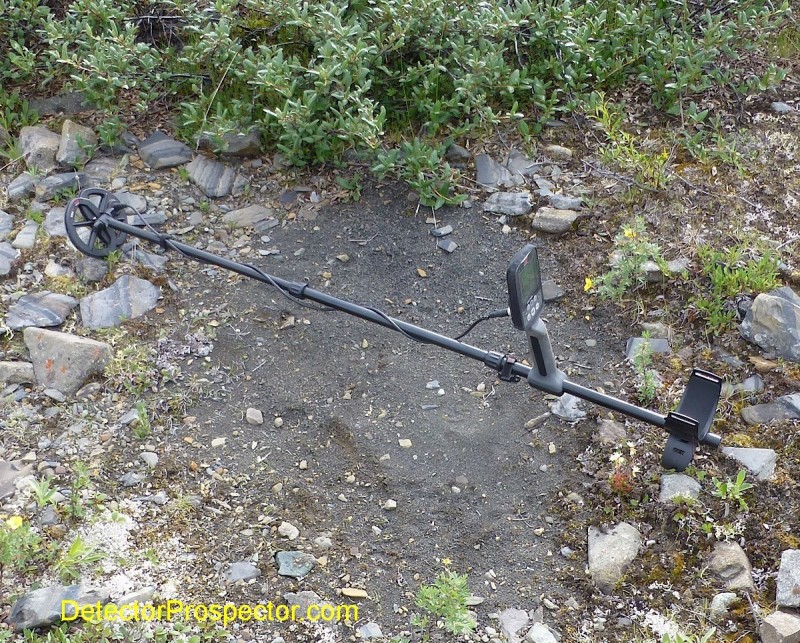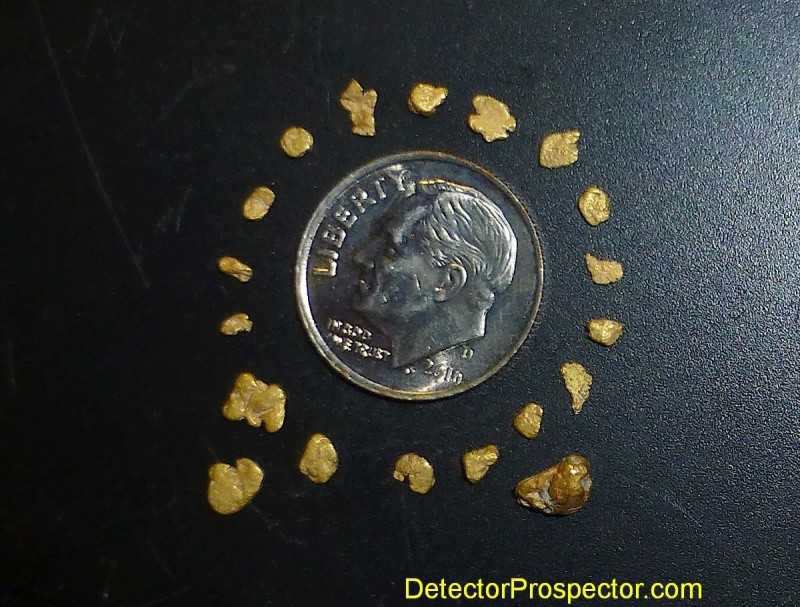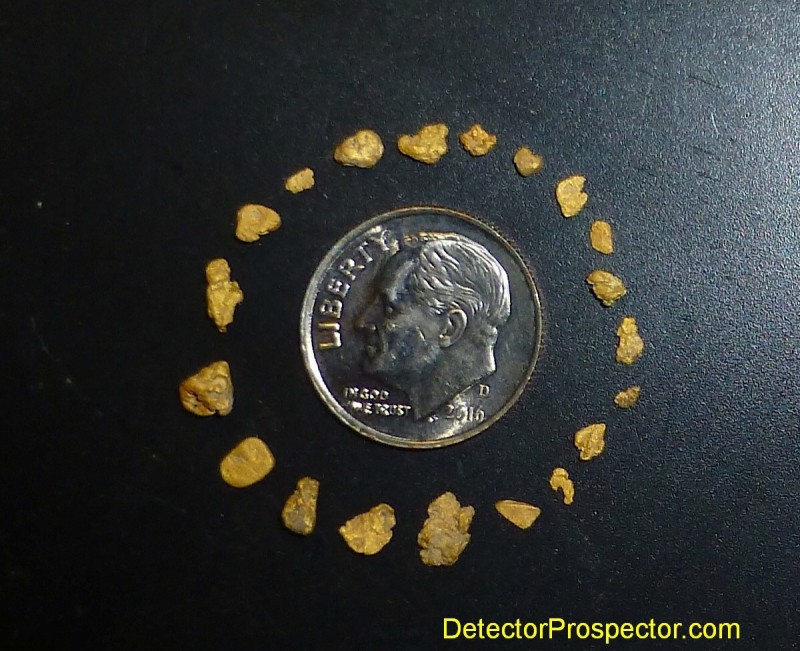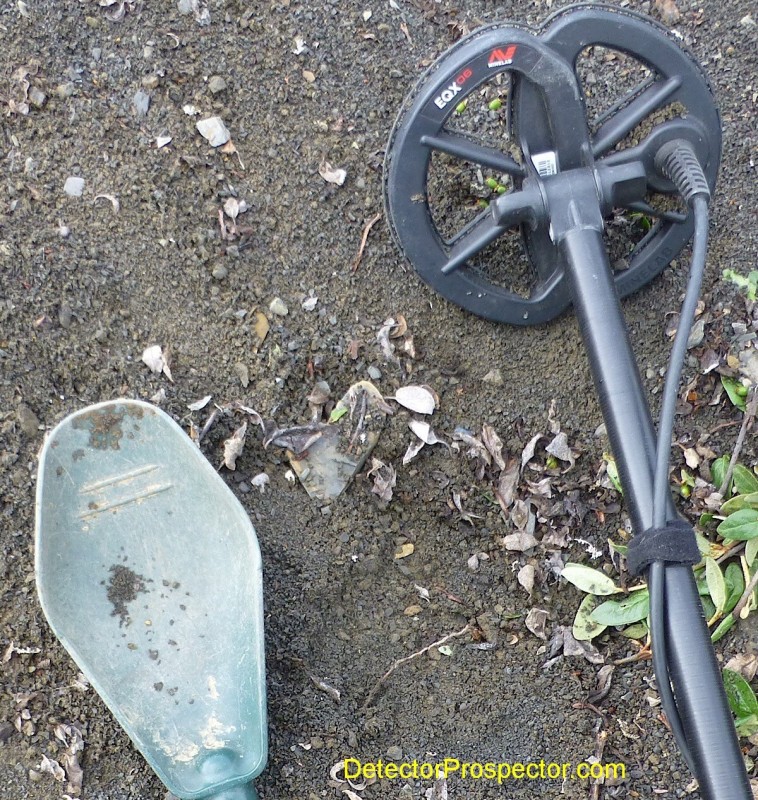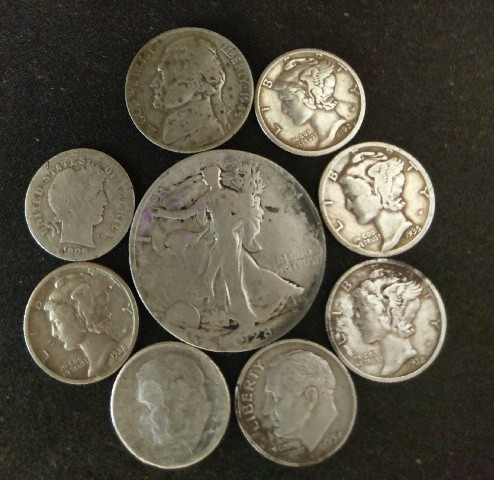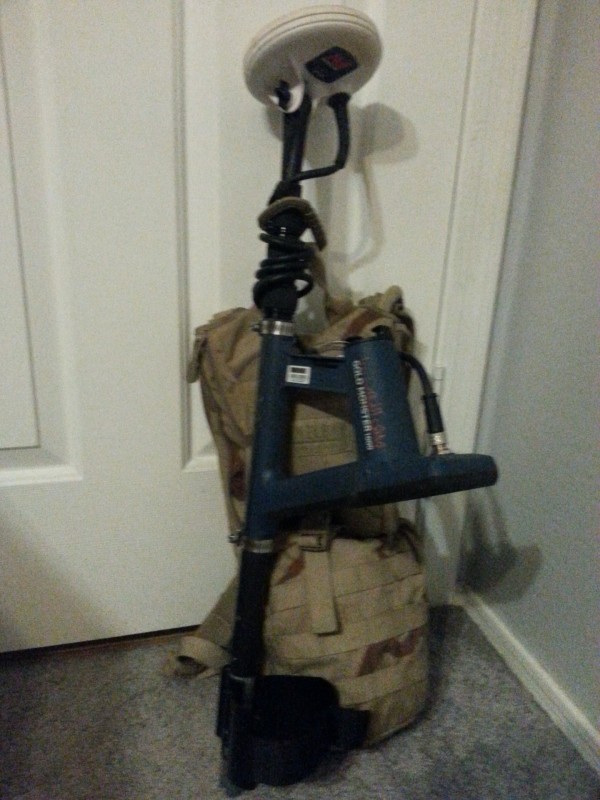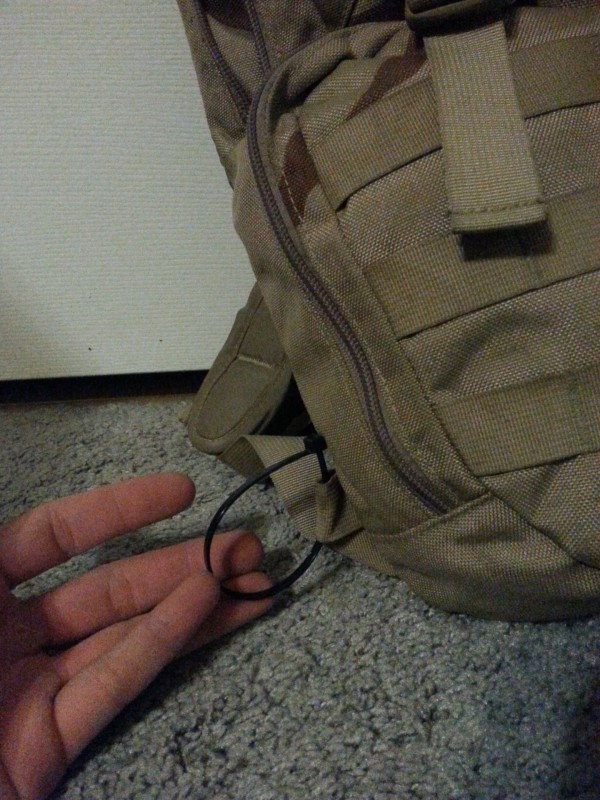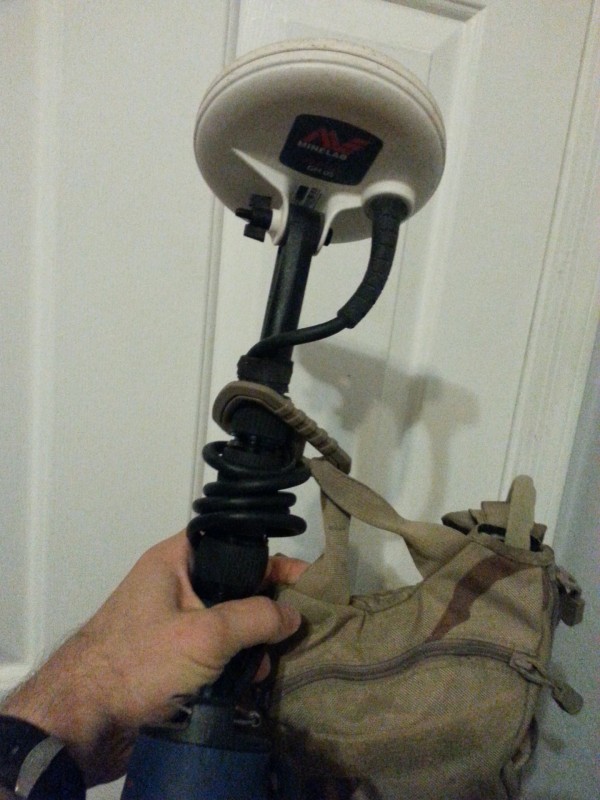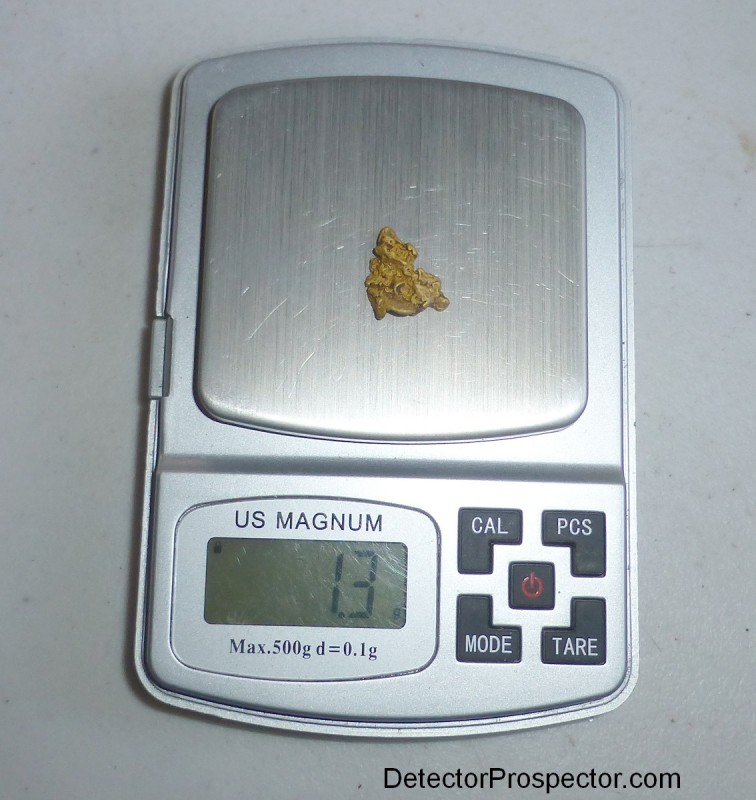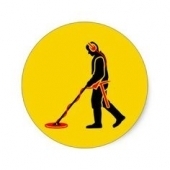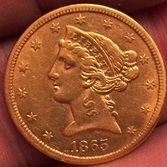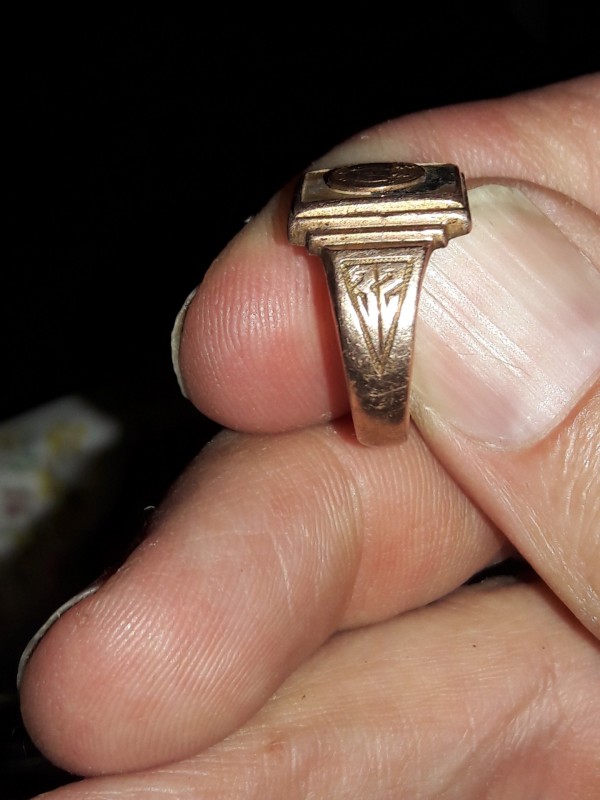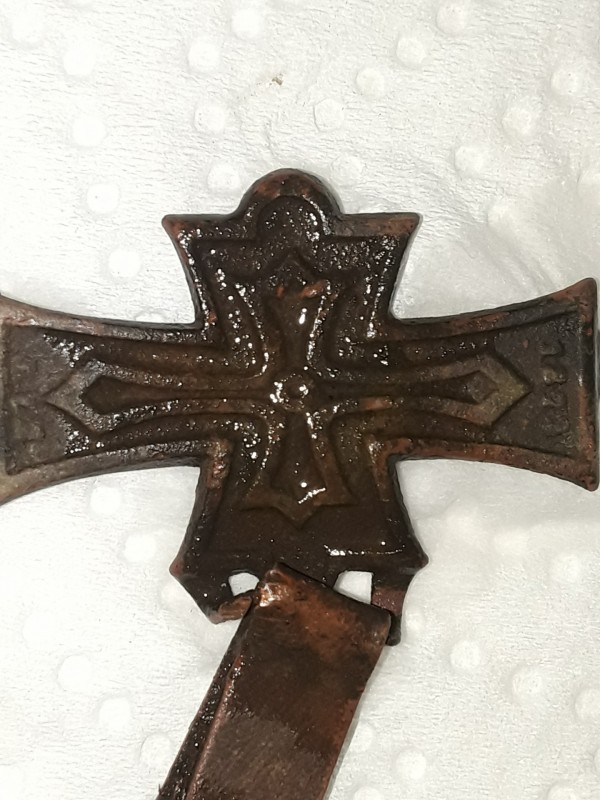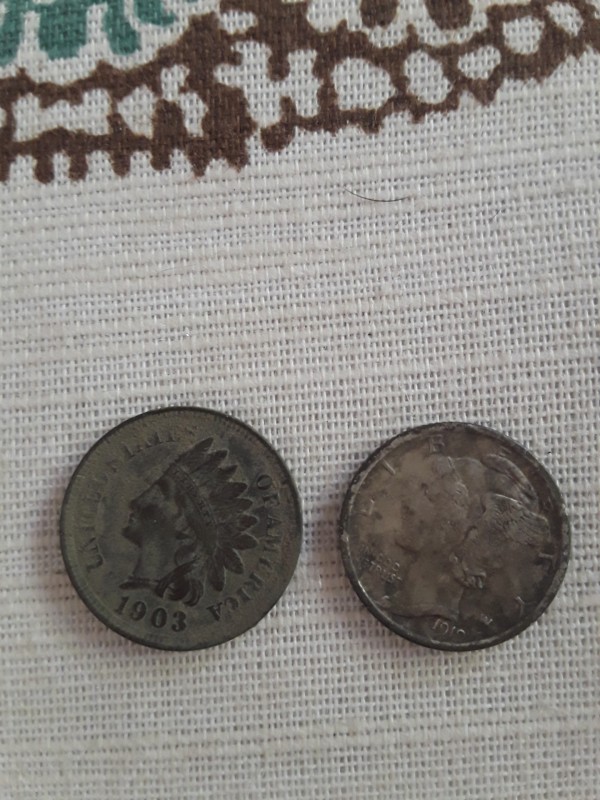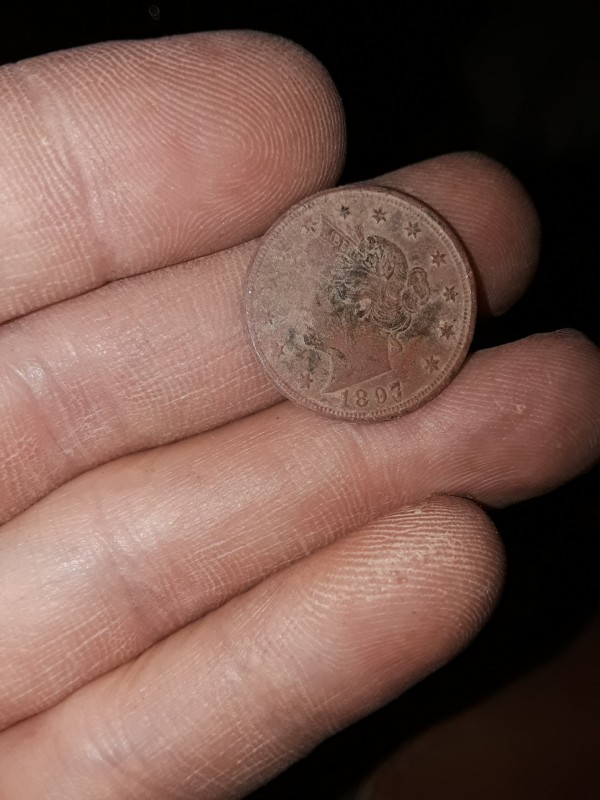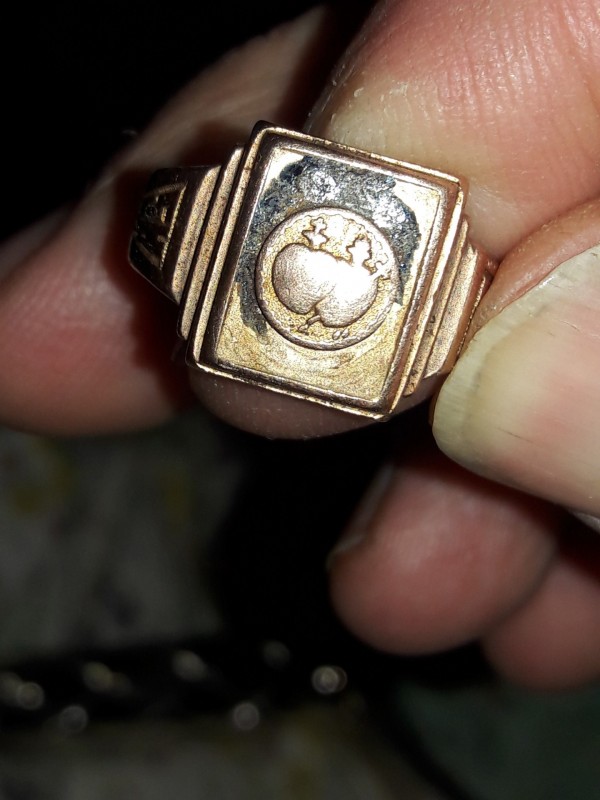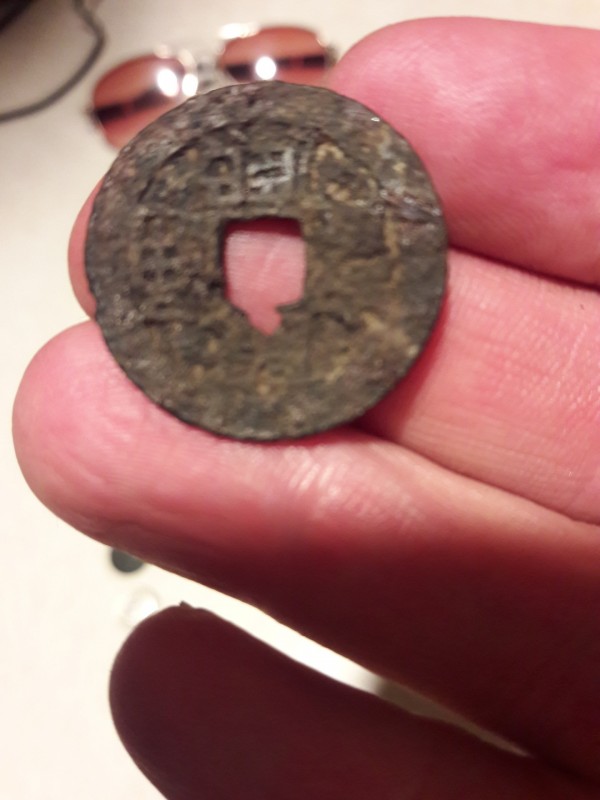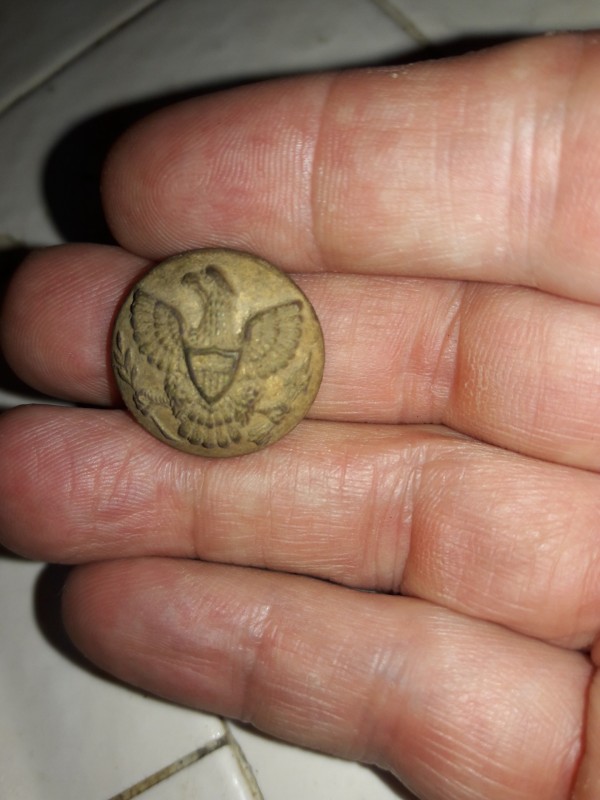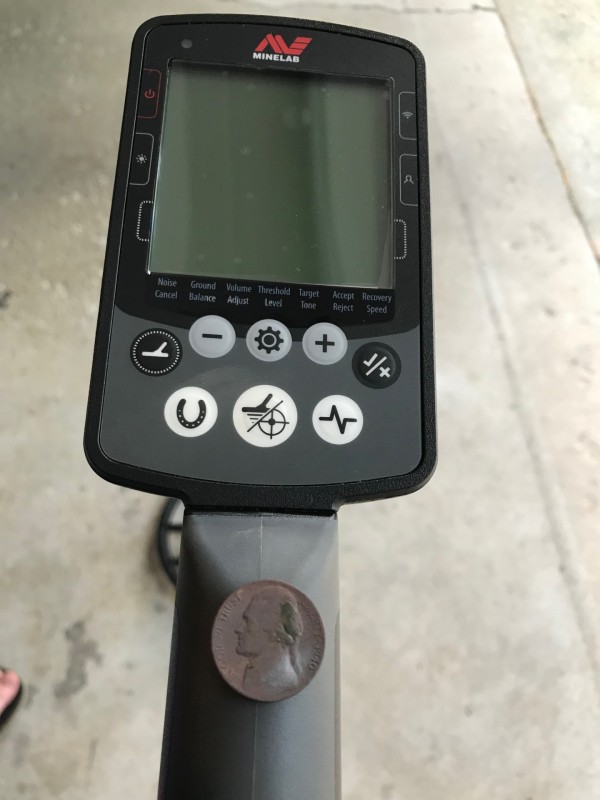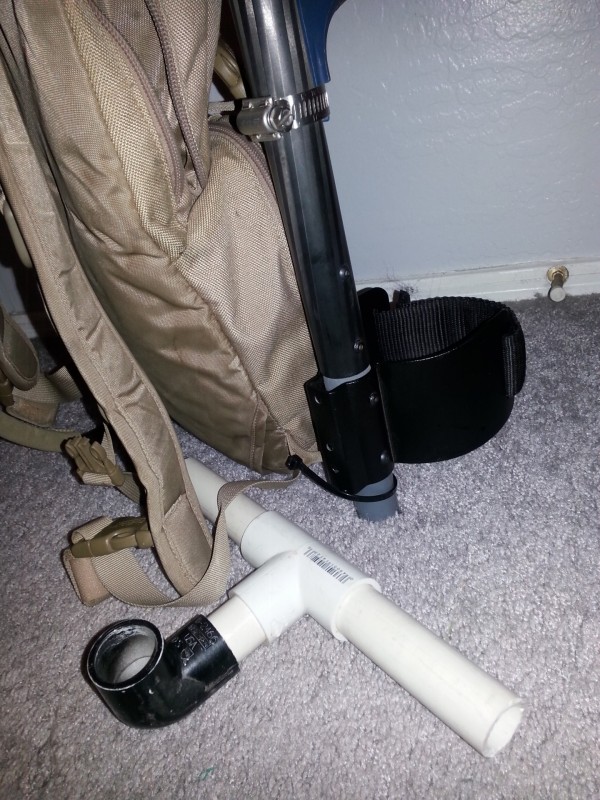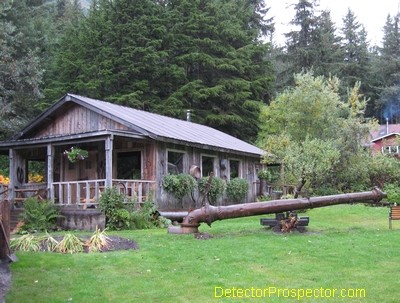Leaderboard
Popular Content
Showing content with the highest reputation on 09/08/2018 in all areas
-
A comment I made on Jins post recently reminded me of how easy it is to walk over good sized gold. We are all familiar with the horrible loud screams detectors make over big surface targets. Sometimes the cause is obvious, usually surface rubbish such as a visible piece of tin or squashed beer can. Occasionally, when walking paddocks (which I mostly do) it turns out to be something useful, such as a lost spanner or fuel cap from a tractor - I have even found a grease gun lying concealed in the grass. These items I always return to the grateful landowner. More commonly, however, it is something useless like an old horseshoe, worn out cultivator point and/or the sheared bolts which once held it to the plough tyne. After digging a number of these the temptation to keep walking (with ears still ringing) becomes ~almost~ irresistible. Back in the Minelab SD2200 days I had permission to work a large Victorian property located on the Tarnagulla granite pluton to the north of Dunolly. This had a number of unworked shallow Tertiary palaeochannels crossing it, on one of which I located a 7 oz patch. Mostly the gold was smallish and reasonably deep, but the same location was also littered with shallow shotgun shells. These were very loud and nearly drove me nuts, and in my frustration I ignored one outlier - - - Fast forward a number of years and, armed with later technology (GPX4000) I decided to check the patch once more and - - - WHUMP/SCREAM - - - greeted my ears over that same target. I kicked the dirt in annoyance - and then spotted the 70 grammer I had ignored years earlier: I had foolishly made the assumption that all the gold in that patch was deep and small, therefore loud shallow targets had to be junk - overlooking the possibility that something once deep could have been ploughed to the surface - - - I kept it to remind me of the old detecting maxim: "Dig your targets"17 points
-
Hello all, I made an interesting find with the Nox the other day. I was detecting an early 1900s military site in Montana and found a copper or brass arrowhead (left in photo). I did a check online and found a few similar ones which are described as "fur trade era" arrowheads. They were apparently commonly made from scrap metal, copper kettles, etc. The Crow were said to have been expert at making these points. The other arrowhead I found at a different military camp in Colorado from the late 1860s over 20 years ago. I suspect that these points had nothing to do with the military camps, but were instead lost by native hunters. These are the only two metal arrowheads I have found since I started detecting in 1977. Just curious if anyone else has found a metal arrowhead.6 points
-
6 points
-
On my first Oz trip Larry took to a well worked spot. I got a very loud signal under a salt bush. I figured junk but gave it a scrape anyway....a 3/4 oz piece that I expected to be junk right on the surface...my best piece of the trip! You never know until you see it. fred5 points
-
I have been told more than once that my largest find (find of a lifetime as Fred puts it) was a matter of 'luck' and 'not knowing any better' because the target was relatively close to several camps in the area and was on the National Trails Highway in Arizona. The reason I would have enjoyed such luck with my 5000 and 18" NF was I was hunting in an area that had deep 50 cal bullets and shells and it had a lot of surface meteorites. My signal was big and deep so ... maybe someone had ignored it down in the bottom of that little swail thinking they knew it was trash. It turned out to be a very nice specimen with 8ozt of gold in it. Mitchel4 points
-
Hello All I wanted to share another case solution. This is a Plano gun case that I purchased from Amazon Canada. Nice case for $100. It took a little time to pick out all of the plugs but at least all of the parts have a place now. The left over plugs will be good for padding other stuff too so I'm saving them for now. Edit: I just realized that there is not much room for headphones but I don't use them and I'll probably go with ear buds if I ever do. My main concern was providing as much protection as possible to the gear in case I fly with the case. https://www.amazon.ca/gp/product/B00E221A88/ref=oh_aui_detailpage_o00_s00?ie=UTF8&psc=13 points
-
LS.PELSO Waterproof Headphones for the Minelab Equinox Colonel Dan 5 September 2018 I had an opportunity to test these new waterproof headphones for the Equinox and wanted to share my thoughts with those on this forum. Rest assured, I have no financial interest in these headphones and am under no obligation in any way to Kellyco, the retailer. ~~~~~~~~~~~~~~~~~~~~~~ Upfront Disclaimer: I'm neither an engineer nor an employee of Kellyco, I'm just a guy who uses his detecting equipment like many of you. The internal technical details of how the equipment is manufactured and functions I leave to the experts. This independent review is strictly from the average Equinox user stand point and focuses on what detectorists like me look for in a good set of headphones. First Impression: Solid. My initial impression of the LS.PELSO headphones was how solidly constructed they were; no flimsy materials anywhere. The cable was especially impressive; first class quality all the way and long enough to ensure ease of use without placing any strain on the cable. Fit and Comfort: Very good. Sufficiently tight without unduly squeezing your head as some headphones I've tried. They're easily adjusted for proper fit and stay in place very well even under sweaty conditions. The ear pads are soft, comfortable and well fitting. Ambient noise reduction: Excellent. The LS.PELSO headphone base unit was originally designed for hearing protection/noise reduction and modified to include underwater speakers. Consequently, they reduce outside noise extremely well. The true test; I could easily hear faint signals of small deep targets with negligible distracting sounds from the environment. Tone Quality: Exceptional. The speakers provide outstanding tonal quality under all test conditions. Clear, crisp and distinct. These headphones don't use piezo technology but high quality underwater speakers...a big difference in my view! Faint Signals: Excellent. The combination of effective noise reduction and high quality tones produced by real speakers work hand in hand in producing those faint whispers where many good targets try to hide. With these headphones, I could pick up those small targets at depth well enough to certainly prompt me to dig them. Durability: Looking good. I obviously can't report on long term durability since I only had these a few days for testing and review purposes. Having said that, based solely on the observed quality of the materials and construction, I'm going to bet these will be more durable than many I've used. Waterproof: Absolutely. I think the best testimonial I could provide comes from a hunting buddy who had his set completely submerged for 30 minutes and they worked perfectly throughout. Speakers vs Piezo: I can't testify as to any detailed engineering specifications but I can and will say this; these are the first headphones I've ever had on my head where I had to turn the volume down on my detector. Although these headphones aren't equipped with an independent volume control, I never missed that feature. The volume control of my Equinox was more than sufficient for adjusting it to a comfortable level. When I first turned on my detector with these headphones attached, I was indoors and the Equinox volume was set at 25--they nearly blew my ears off. Outdoors, I was certainly able to adjust the volume sufficiently to insure those whispers were heard. On other headphones I've used with an independent volume control, I had to keep them at max level. As noted, these headphones utilize true underwater speakers and are thus far beyond any I've used which employ piezo technology. Conclusion: I'm sorry I had to give them back after testing but I will have a set of these. They're truly superior water proof headphones in my estimation and will become my “go to” set for the Equinox in and out of the water! Now you may ask, “Why would I need a set of waterproof headphones? I don't hunt in the water.” Have you ever been caught in a downpour? Ours is an outdoor sport and when it rains, I certainly don't want to risk my non-waterproof wireless Equinox headphones. These LS.PELSOs are just the ticket for both excellent performance and peace of mind but again, that's just the view from my foxhole... https://www.kellycodetectors.com/catalog/ls-pelso-underwater-headphones3 points
-
3 points
-
Spot on with your identification for Andy's Hammered Silver it is a Henry VI annulet issue halfpenny of London Mint. Henry VI, 1st reign 1422 - 1430. On the reverse Long cross pattée with three pellets in each angle, annulet in two angles (Dimples).3 points
-
Awesome mate! It's nice to have a the date nailed down. Cracking first Hammy! I sure do miss finding those beauties in the soil. It's an unbelievable feeling to reach down and lift a medieval coin from the earth and see a king/Queen looking back at you ?2 points
-
I've just had kittens! OMFG ? Thanks for that, made my year. Thanks everyone for your kind words, feels good.2 points
-
Hold a coin to the tip while turning it on. If it goes dead, it is apparently the 1st version software; if it does a beeping overload routine, it is the 2nd version. Mine is apparently the 1st version, as it goes dead (I tested several times, and twice I had to loosen battery to reset after that). Still not getting along with mine (bouts of insane falsing) but after doing that secret reset will try to give it another tryout this weekend before sending in for repair. My Whites TRX, almost as deep, has a quirk or two but overall works quite well; so if the F-Pulse doesn't pan out, I'll just stick with it.2 points
-
If it were me, I'd probably keep the Explorer XS as the backup, so long as it has no significant problems other than the rechargeable battery (you can replace that with a better aftermarket one or just go on using the alky pack, since it presumably won't get too much use as a backup). I consider my Etrac (essentially an updated Explorer) a good complement to my Nox (I prefer the Etrac over the Nox for most things), and there are a lot of reasonably-priced coils available for the Explorer/Etrac line (they use the same coils). But if I were going to buy a new machine as a backup (and that is completely valid), it would probably be the Multi Kruzer. I've heard good things about it, and would find it interesting to try a new machine and compare it against the Nox. The caveat here is that if I used my detector a lot and considered it a necessary daily tool (not the case for me), I would instead buy another Nox as the backup just so there would be a seamless transition if my primary machine ever went down. That's what I do with laptops since they are necessary tools for me. My two cents.2 points
-
2 points
-
Here is a video but my lense must have gotten some dust on it because it’s blurry... Anyway, it shows the process.. ? https://photos.app.goo.gl/vgthiQ2HUJdesZDq92 points
-
Gold Nugget Detecting with the Minelab Equinox Metal detecting for gold nuggets is one of the most difficult detecting tasks, and learning to run a VLF detector in highly mineralized ground will challenge even the best detectorists. There is more to this subject then can be covered in a brief article but I will try and offer some tips to get people started with the Minelab EQUINOX for gold nugget detecting. Minelab Equinox with 6" coil at work gold nugget detecting Tiny nugget in scoop - the Equinox can find very small gold nuggets! The EQUINOX 800 has two modes that are not available on the EQUINOX 600 – Gold Mode 1 and Gold Mode 2. The two Gold Modes as far as I h e been able to determine are identical except for the default settings. Gold Mode 1 is set up with a default Recovery Speed of 6 and Gold Mode 2 is set up with a default Recovery Speed of 4. These modes employ a boosted audio that increases both in volume and pitch as a target is detected. This in turn accentuates the signal on tiny gold nuggets. The threshold is also different than the “reference threshold” employed in the other modes and is more responsive to ground changes, providing important audio feedback about changing ground conditions. The Gold Modes are similar to the threshold based all metal modes available on most VLF nugget detectors with a major difference. A target id number is displayed for strong targets and each target id number can be independently set to accept or reject. In this regard the Gold Modes are a hybrid mode with more discrimination capability than is available in normal threshold based all metal modes. Normal VLF nugget detecting relies on the operator having their ear very tuned into the threshold sound of the detector. Slight variations in the threshold tone can indicate potential targets. The threshold tone is also very sensitive to changes in the ground mineralization. This includes the so-called “hot rocks” which have mineralization different than the ground they reside in which makes the detector react to them as targets. The challenge is to get the detector to operate with a relatively smooth threshold as the coil is swept over the ground so that desired targets will stand out. If hot rocks are signaling with every sweep of the coil, then progress will be extremely slow if not impossible. Tuning a VLF detector to hunt nuggets starts with the theoretical most powerful settings, and then reduces those settings until the detector becomes stable. Every setting is a trade off, because making a detector more sensitive to gold also makes the detector more sensitive to mineralized ground and hot rocks. The key settings for the EQUINOX 800 in Gold Mode are: Frequency. Multi frequency is the default and the most powerful frequency setting, with 40 kHz and 20 kHz single frequency options. Multi is the most sensitive to gold, but also reacts the most to bad ground and hot rocks. The goal is to get the EQUINOX to run well in Multi but if bad ground or hot rocks make that impossible, going first to 40 kHz and then to 20 kHz will make the EQUINOX progressively less reactive to the ground and the hot rocks. Ground Balance. The default is ground tracking on. Tracking attempts to keep up with and smooth out the variations in the ground. In doing so it has a filtering effect and can possibly tune out the slight audio variations that come not just from the ground but from very small or very deep gold. Tracking off is therefore the most sensitive setting, with adjustments made via the Auto (pump) method or manually. Sensitivity. The range is 1 – 25 with a default of 20. Increasing sensitivity increases the audio response from all targets, plus the responses from things like electrical interference. Most importantly, too much sensitivity makes the ground itself into one giant target, and so if the detector refuses to ground balance properly then reducing sensitivity until a proper ground balance can be obtained is critical. The default of 20 can easily be too high for the worst ground, and settings in the mid to low teens may be necessary. Recovery Speed. The range on the EQUINOX 800 is from 1 – 8. The defaults are 6 for Gold Mode 1 and 4 for Gold Mode 2. Recovery speed as regards nugget detecting can be viewed as a smoothing filter. Higher settings act to smooth out audio responses from the ground and hot rocks. Lower settings enhance audio responses from weak gold signals, but also make hot rocks and bad ground stand out more. False signals from the coil bumping a rock also increase at lower settings. In general the EQUINOX will be easier to handle at higher Recovery Speed settings, with more careful coil control required at lower settings. Iron Bias. The range is 0 – 9 with a default of 6 in both Gold Modes. Lower settings reduce the chance of gold being identified as ferrous, while higher settings reduce the chance of ferrous items being misidentified as gold. Accept/Reject. The default is -9 through 0 rejected, 1 through 40 accepted. The discrimination range on the EQUINOX runs all the way into the ground signal, with ground signals in highly mineralized ground normally coming in at -9, -8, and possibly -7 though it depends strictly on the ground itself. Hot rocks can read almost anywhere, even in the positive number range in the mid-teens or elsewhere. Electrical interference is also likely to exhibit in the low negative number range. Any offending numbers including trash targets can be blocked directly, but the more numbers that are blocked or rejected come at a cost of slightly less signal strength on desired targets. Threshold. The range is 1 – 25 with a default of 12. This is normally set to be just loud enough to hear, but no more. Just a barely discernible tone. However, the threshold can also act as a backend filter. Once all other tuning has been completed, the threshold can be set lower until it is silent, or set higher than normal. Running silent can suppress small variations in the ground signal but also the weakest gold signals. Running the threshold higher than normal can smooth out weak variations, again with a subsequent loss on the faintest gold signals. My starting point (initial settings) for either Gold Mode are: Frequency: Multi Ground Balance: Auto (pump method) with manual tweaking Sensitivity: 20 Recovery Speed: 6 Iron Bias: 0 Accept/Reject: -9 through 40 accepted (either through the settings or by hitting the “Horseshoe button”) The main thing I am going to try and do is operate the EQUINOX in Gold Mode without blocking out or rejecting any target id numbers. The goal is to find settings that reduce and smooth out ground responses while reducing the signal from gold as little as possible. These two things fight each other and there are no perfect settings, but simply the best compromise possible. For some people that will mean making the machine very stable, while others may prefer hotter settings that require more audio interpretation from the operator. The first step is to find an area clear of trash, and walk a bit waving the coil over the ground. Chances are you will get lots of ground noise. Go into the settings and adjust the ground balance. This normally means pumping the coil over the ground while holding the accept/reject button (see the manual) until the ground response evens out. If the ground is highly variable with mixed hot rocks, waving the coil from side to side may work better than pumping the coil. With any luck the machine will settle right down. However, in bad ground it will not, and the solution normally will be to lower the sensitivity setting. Basically this just takes some experimentation, lowering the sensitivity and adjusting the ground balance until the detector reacts very little or not at all to being waved over the ground. If you can get the EQUINOX set to where no target id numbers are popping up at all as the coil passes over the ground but where you can still hear faint variations in the ground, you are there. Then it is simply a matter of going detecting, and digging every target that stands out above the faint ground variations present in the threshold tone. Gold can read anywhere from negative numbers all the way up into the 30’s so typical nugget detecting involves digging everything. However, most nuggets weighing under 1/10th gram will give a target id number of 1 or 2, nuggets under a gram in the single digits, and several gram nuggets reading in the teens and higher. The smallest or the deepest large nuggets will produce no target id number at all, just a variation in the threshold. In real bad ground you may have to not only reduce the sensitivity setting, but possibly even increase the recovery speed setting to 7 or 8. In ground that refuses to behave, switching to first 40 kHz and then 20 kHz will progressively detune the EQUINOX , making it easier to get a stable ground balance. Engaging ground tracking may also help smooth out the worst ground – you have to experiment. In severe ground all this may not work, with ground signals still coming in around the low negative numbers and possibly higher. Some hot rocks may read as positive numbers. This is where the EQUINOX can go to the next level. Go into the settings and reject or “notch out” the worst offending target id numbers. This will usually be -9, -8, and -7 but may include even higher numbers, including positive numbers. Block as few numbers as you can. Simply rejecting the bottom three negative numbers will usually settle the machine down a lot, especially if there is any residual electrical interference being encountered. Rejecting target id numbers does come at a cost in reduced signal strength on desired targets, but you may find now that the sensitivity level can be increased from one to several points, reclaiming that lost sensitivity. In theory if you can get the EQUINOX running stable with no target id numbers rejected you have the ideal situation. However, EQUINOX allowing some offending signals to be rejected with an attendant increase in the sensitivity setting may be the better way to go. It just depends on the situation. So far we have been trying to deal with bad ground by using various detuning methods. In low mineral ground you can go the other direction. If the detector ground balances immediately with a sensitivity setting of 20, then try higher settings. You can also try reducing the recovery speed setting from 6 to 5 or 4 or even lower. Each reduction of the recovery speed setting is fairly dramatic and you will find it suddenly very hard to get and hold a decent ground balance if you go too low with the setting. In mild ground however it can add substantially to the signal strength of the weakest targets. Finally, for the worst ground and for EQUINOX 600 owners we have other alternatives. There is no reason at all why the other modes cannot be used to nugget hunt. Park 2 and Field 2 are both very hot on small targets and offer the ability to use tones while nugget hunting. Prospectors who encounter salt lakes/salt flat situations would do well to remember the Beach modes as possible last ditch settings. Either Park 2 or Field 2 can make for very good nugget hunting modes. I prefer to use Park 2 as a base because by default Field 2 blocks out or rejects the key target id numbers 1 and 2. Small gold nuggets read there, so using Park 2 makes sure somebody will not accidentally reject nuggets in that range. You can use Field 2, but beware those blocked numbers and adjust accordingly. For Park Mode 2: Frequency: Multi Ground Balance: Auto (Ground pump method with manual tweaking) Sensitivity: 16 – 25 Recovery Speed 800: 4 - 6 (default is 6) Recovery Speed 600: 2 - 3 (default is 3) Iron Bias: 0 Accept/Reject: Everything accepted, rely on tones (alternative reject -9, -8, and -7 if too much ground feedback) I have suggested accepting everything, and then using the two tone mode to hunt by ear. If trash is minimal then set the tone break lower than normal, so that 0 and several negative numbers read as non-ferrous. This way you can have ground signals reading as low tones (and possibly at a lower volume) and signals from gold as higher tones. Again, this works well with both EQUINOX models. To sum up, I suggest trying to use the EQUINOX 800 in the Gold Modes with no target id numbers rejected. Tune up just like any normal nugget hunting detector, and dig all decent audio signals. Some nuggets may deliver a negative number response or no number at all. A secondary method for more difficult ground is to reject or block out offending ground and hot rock signals. And a third method for both EQUINOX 800 and 600 owners involves using the Park 2 mode as a nugget hunting mode. That should give people plenty to experiment with. Nugget detecting can be very challenging, but learning to do so means you will learn how to wring every bit of performance possible out of your EQUINOX , and that can benefit you in other areas of detecting as well. Good luck! Steve Herschbach DetectorProspector.com Earlier post on same subject Gold found in Alaska by Steve with Minelab Equinox Gold found in California and Nevada with Minelab Equinox1 point
-
1 point
-
All - I thought I would share an idea on carrying your gold monster. This is more for those of you that hike very far before you are ready to detect, or maybe you already have your hands full with another detector like a GPX or GPZ. It is not an original idea but one I saw recently for carry spare fishing poles. I recently tried it on a night hunt and really liked how it handled. It allowed me to use my GPZ and then switch to my GM1000 when I hit the bedrock. A major caveat is that I have converted my GPZ to telescoping rods, but I think the idea might still be useful for some people. For starters, this is for people who have made their own stand with PVC pipe fittings. you simply remove the elbow at the end of the stand so that you have a straight piece at the end. This is key, because the first contact point is low on your Camelpak (or other backpack). For this low contact point, you need a zip tie or similar method to make a loop. This is where you put the pole end of the GM1000, then you swing it over your shoulder and hook it to a caribiner that is latched to a high point of the backpack, typically the carrying handle. I used a caribiner but you could sew a velcro loop on there with back pack clips. There are many ways of doing this. Whichever way you choose, don't forget to bring the stand with you. ?1 point
-
Interesting and shows just how subjective weight, balance, and hand grips are. I don't think it is really possible to make a properly balanced detector under 3 lbs because stock coil size/weight determines how a detector will balance. The only way to properly balance a detector is to add weight under the elbow, and the obvious way to do that is put the batteries there. A certain amount of offsetting weight is needed, and reducing the eight AA batteries to four (for instance) would shave a little off the weight but also make the detector more nose heavy. I therefore consider the MX7 to be better balanced than the lighter Equinox (or Deus or any other under 3 lb detectors) and that makes for a better feel on my arm. I prefer the grip on the MX7 also. But that's just me! Do keep in mind this is a White's forum. Machine brand comparisons are best posted on neutral ground - the Metal Detector Advice & Comparisons Forum.1 point
-
We all know that the Sport comes with the 10” DD coil. I have the 7”DD, 6” concentric, 9.5 concentric and the 6 X 10 DD but yet used the 9.5 concentric coil . I have it on now and if it will stop raining I plan on detecting with it next. I’d say all the other coils work great but I have a soft spot in my heart for a concentric coil, I’m going back over some of the places I’ve hunted to prove to myself that the concentric gives you more depth than others. I was just giving a air test on the 9.5 concentric to see if it gave the same ID on a coin flat to the coil are on edge and it did. I can’t say the same for the other coils but will check it at a later date . I don’t know about the rest of you but I’m putting that TDI Beach Hunter on my wishlist for Christmas. The Best To All ! Chuck1 point
-
A note on Recovery Speed. The basic story is lower Recovery Speed settings draw out and elongate/enhance all audio signals. In low mineral ground and sparse targets you can in general say lower is better. In areas with electrical interference lower Recovery Speed settings tend to reduce EMI "chatter". However, the detector gets touchy in bad ground at lower Recovery Speed settings. Ground response is magnified as well as responses from hot rocks. If the Recovery Speed setting is too low the detector will not even want to ground balance on bad ground. Hot rocks will react more strongly at low Recovery Speeds, and can act to mask adjacent gold nuggets, just like a coin can be masked by a piece of trash in a park. Trash items like nails can obviously act to mask nuggets also, and so low Recovery Speeds will enhance nugget masking in trashy locations. Coil knock sensitivity is enhanced by low Recovery Speed settings. This is a problem in particular with the stock 11" coil, not so much with the 6" coil. If the coil seems overly sensitive to being bumped against things, increasing the Recovery Speed will help alleviate this. Which all gets back to that the simple out of context "lower Recovery Speed equals more depth" is an incredibly misleading statement. It is just as accurate to say that higher Recovery Speeds can reveal targets missed by lower Recovery Speeds. If a lower Recovery Speed results in a missed target due to masking, how exactly is that "going deeper"? Anyway, long story short is if you look at a lot of my earlier writing I tend to fight back hard on this idea of "lower Recovery Speed equals more depth", especially as regards nugget detecting with the 11" coil and knock sensitivity. With the 6" coil out now I am lightening up on this because the benefits of lower Recovery Speed are immediately obvious with the 6" coil and on tiny gold in particular. For covering ground I still lean to the higher Recovery Speed setting, but when down and dirty hunting a 20 square foot patch with the 6” coil at a snails crawl low Recovery Speeds can really enhance tiny targets.1 point
-
There are a lot of posts with good information but every once in a while one comes along that is so densely packed that it's worth bookmarking for repeated reading. Steve, you've created another one of those. Thanks!1 point
-
I bought an MX Sport last week. I put about 25 hours on it this week. I’m very impressed with it. I’m going back to places I’ve hunted extensively and I can’t believe how much I’m finding. First day I found a 1920 Merc dime, here in Canada. I’ve dug around 300 coins this week. Did I have those other detectors even turned on?1 point
-
Thank you everyone. This should not be read as the be all end all of nugget detecting with the Equinox. It is a very powerful and subtle metal detector, and so everything I wrote is just a good beginning. I am still learning little things with each new outing to new locations. One thing I think I am seeing is that Multi has built in ground canceling capability not available with single frequency detectors. It has been well noted that for many locations and regular detecting you do not need to ground balance the Equinox at all. This is because the multifrequency processing is doing a lot of the work up front and so the ground balancing procedure only need take place in extreme ground. This exhibits when nugget detecting in that hot single frequency detectors have a very touchy ground balance setting. A Gold Bug 2 for instance, you have to deal with very fine ground balance adjustments. Just a hair off in either direction, and the detector reacts very strongly to the ground. The Equinox by comparison seems to be able to fudge the setting with less dramatic negative results. This can be very handy when dealing with hot rocks. The last location I worked was northern Nevada, mildly alkali (salt) type ground. The Equinox with small coil and sensitivity 17 wanted to ground balance at 6 to make the ground not react at all. However, at this setting there were reddish rocks containing maghemite that were giving positive signals. Maghemite is one of the nastiest minerals a detector has to deal with. From Advanced Nugget Hunting With the Fisher Gold Bug Metal Detector by Pieter Heydelaar & David Johnson, page 33: ”Maghemite is gamma ferric oxide. It is red or reddish brown in color, and usually has an earthy texture. It commonly occurs in rocks that have been chemically altered by fire (forest fires, camp fires, etc.) or weathering, and in red or red brown soils. Some tropical or sub-tropical clays may contain more than 10% maghemite and may be so magnetic they will be drawn to a magnet. In many gold prospecting areas, “hot rocks”, which are of ordinary appearance but sound like gold, owe their obnoxious behavior to their maghemite content.” I played with one of these hot rocks a little. The rock went quiet at ground balance setting of 0 but now the ground was reactive. I settled at a ground balance setting of 2, which still kept the rocks quiet while still allowing for quiet operation over the ground. You can play these ground balance offset tricks with single frequency detectors, but it is much harder to get it right. Multifrequency seems to allow for more slop in the ground balance setting without the immediate negative aspects seen with most single frequency models. I have been using my Equinox in preference to my Gold Monster purely due to all the adjustability. The problem can be too much adjustability for many people. The Gold Monster basically gets the job done with almost no tuning expertise required at all. The Equinox has impressive capability also, but favors people like me that want full control over all the tuning aspects. I appreciate being able to manually ground balance, and I do like my threshold control, and therefore I lean Equinox. I admit I also like the challenge of learning new things also, and the Equinox appeals to me there also. I am not casting my Gold Monster aside completely however. There also are times when quick and dirty simplicity is all I need. When I test most nugget detectors I concentrate on their ability to find small gold. Small gold nuggets require a detector to be tuned up as hot as absolutely possible to just be able to detect the gold at all. This hot tuning however makes bad ground and hot rocks react. What really sets nugget detectors apart is not their ability to find gold. It is how well they can handle bad ground while still finding the gold that counts, and this is the reason that air tests have so little value for nugget hunters. This does mean I have not really looked for larger gold with my Equinox. If I am hunting big gold, I am more inclined to grab my GPZ 7000. Yet I suspect that the Equinox may be one of the best VLF options that exist currently outside pulse induction type technology for hunting larger gold since Equinox really does pack the punch on gold range targets. The largest nugget I have found so far with the Equinox was more an accident while chasing small gold.... 1.3 grams from my recent Alaska trip. I have proved to myself that Equinox can perform on small gold, but now I need to see how well it can do on larger gold at depth in trashy areas where my GPZ is going to go nuts on the garbage. 1.3 gram Alaska gold nugget found with Equinox and 11" coil1 point
-
* Here below in bold red print is the nearest conversion which I can find to form an equivalent valuation of the buying power of your coin but bare in mind that this information data is not of 2018 but from 2007 so there will be a slight difference in the current equivalent valuation meaning more buying power of your coin. * Purchasing Power of £1 compared to 2007 values Figures supplied by: Lawrence H. Officer, "Purchasing Power of British Pounds from 1264 to 2007," Measuring Worth, 2008. URL http://www.measuringworth.com/ppoweruk/. Year RPI Average Earnings Comments Use for "buying a loaf of bread" type of questions Use for how "affordable" this would be to the average person type questions 1275 £355.39 £11,822.40 1300 £390.93 £10,010.23 Great Famine 1315-1322 1325 £303.93 £7,865.52 1350 £430.26 £6,987.23 Black Death 1348/9 1375 £304.03 £5,067.60 Peasants Revolt 1381 1400 £400.78 £5,283.69 1425 £472.29 £4,958.07 ******** 240 Pennies to the pound ( £ ) ********* 1450 £520.14 £5,246.55 Wars of the Roses 1455 1475 £549.74 £4,755.63 Plague 1498 1500 £501.55 £4,755.63 1525 £466.79 £4,755.63 Reformation 1534 1550 £243.02 £3,780.97 1575 £184.16 £2,441.86 First Treaty of Nonsuch 1585 / London Plague 1592–1594 1600 £141.16 £1,947.48 Gunpowder Plot 1605 1625 £138.24 £1,776.22 1650 £87.99 £1,533.37 Plague 1665 / Fire of London 1666 1675 £125.66 £1,449.82 1700 £130.43 £1,604.57 Bank of England Formed 1694 1725 £123.10 £1,572.26 South Sea Bubble 1720 1750 £138.67 £1,445.15 1775 £97.63 £1,312.79 First cotton mill 1771 1800 £52.03 £769.62 Corn Laws 1815 1825 £66.59 £776.42 Railway Age starts 1825 / Met Police Formed 1829 1836 £75.52 £784.33 Cholera 1832 / Epsom's New Work House started 1836 1850 £82.37 £746.30 Penny Post starts 1840 / Irish potato famine 1845 1875 £67.55 £502.61 1900 £77.58 £421.01 1914 £68.80 £360.15 WW1 Starts 1918 £34.91 £172.39 WW1 Ends / Flu Pandemic 1925 £40.88 £181.88 1939 £44.44 £169.89 WW2 Starts 1945 £30.93 £97.90 WW2 Ends 1950 £24.69 £73.23 1975 £6.04 £9.51 2000 £1.21 £1.311 point
-
1 point
-
I bought the Anderson shaft mainly because he includes a carbon fiber lower rod and a sturdy metal arm cuff. With the minelab cuff and the anderson rod the weight was almost exactly the same with the minelab rod just very slightly lighter. With the anderson metal cuff It was slightly heavier than the stock rod, but not noticeable IMO. I like it because it's rock solid now. Even though my stock rod seemed tight once I shimmed the cam lock, it still felt like something was loose when swinging. It might have been the arm cuff (I shimmed with tape too so it was a tighter fit on the rod). The one thing about the Anderson is that if you use his cuff, there's no built in stand on the underside. I ended up making one out of nylon round stock and delrin and now I'm very happy with it.1 point
-
1 point
-
Congrats on a GREAT find Andy!-----Man, don't mess with that coin--leave it just like it is & the way you found it.----------Del1 point
-
1 point
-
Beauty, Andy! You seem to be an enthusiastic, motivated person by nature and I bet this really gets you're detecting blood flowing. ? Next up, gold coin?1 point
-
I have the Equinox 800 and Makro Multi Kruzer and couldn’t be happier. The Multi Kruzer has a great selection of factory and after market coils available, build quality is the best out there and like the Equinox it’s also waterproof.1 point
-
Excellent article, Steve; very informative and easy to understand...you’ve covered all the bases for nugget hunting with the Equinox.1 point
-
OMG -LOL ? Oh hell no, I'm not old. Can't see, can't hear, OBVIOUSLY I can't read. Yes we used to go to Imperial Beach down the way from Coronado every year. Sorry about that. I feel like Roseanne Rosanna Dana. On the old SNL she would go on an on about some subject, "What's all this non-sense about "ENDANGERED FECES." How can Feces be endangered? There is plenty of feces to go around." She would go on a 5 minute rant until Chevy Chase would say, "Rosanna, it's not endangered feces, it's endangered species." Oh, well, then. never mind! Doc1 point
-
Hit some nice spots this summer, got an interesting class ring that looks like from 1932? No markings but it tested 14 karat, which is uncommon for class ring which I normally 10 karat. Has two hearts for Sacred Hearts and the letters SH on the side. Got my 3rd Indian head in a month, nice V nickel, and some other cool finds. Pretty dry soil out here this summer so nothing very deep, but that's not what I used to nox for anyway.1 point
-
Fantastic finds! That ring is a stunner.. ((drool)) ? -Bill1 point
-
1 point
-
Thanks I have been out twice searching for nuggets and had challenges with the deciphering the noise I got in Gold Mode, did notice it would quiet greatly with 20k or 40k. These tips will help. I know the detector is working because I managed to find very small nuggets of molten aluminum and a tiny grommet for a shoelace or something, one aluminum scrap was so hammered and funky I thought it could be a small silver nugget but feels like aluminum. Otherwise, bullets and casings seem to be the most common Alaska finds, I have found those everywhere I've been. Also just got Clive's Equinox Book and started reading that.1 point
-
Little late to the topic, (new user here) but like many others have said, about 85% of my nickels have beep at 13 with 12% or so coming in at 12. I'm sure that soil grade, depth and coin condition will play a part in the end outcome, but those are the sweet spots. My first nickel (in fact, first coin) I dug with my Nox 800 about a month when I got it was at an old home site I hammered relentlessly with my Garrett Ace 400 numerous times. It was about six inches down and was a banging solid 13, no matter which way I turned. Love those 13's ? -Bill1 point
-
1 point
-
I suspect this is the type of testing that was being conducted in the picture! Heliborne SkyTEM Electromagnetic Survey http://skytem.com/photos/ https://globenewswire.com/news-release/2018/09/05/1565591/0/en/Macarthur-Minerals-Identifies-18-High-Priority-Conductors-for-Gold-Including-Two-Isolated-Discrete-Bedrock-Conductors-at-Hillside-Gold-Project-in-Pilbara-Western-Australia.html1 point
-
Fred, Do you still live on Normal? I need another Field Tester. My records show you have a Swingy Thingy, but not an Ultra Swingy Thingy, is that correct? JW, That car reminds me of a story that gives me chills every time I think of it. Not related to gold unfortunately, still a valuable, "look before you leap" lesson to be learned. So the time frame is 1971. I was a police officer in a town in Illinois. Second in crime rate in the State of Illinois only to Chicago. We had a nice size police department, 185 sworn officers. Small enough to know everyone, large enough that we weren't Mayberry PD with Barney Fife and Andy Griffith. My first assignment was as an undercover narcotics officer. I was undercover for 6 months. I was a real young looking kid, I could have passed for being a high school student, so they threw me to the wolves early. I had just come out from undercover and had been assigned to patrol and to a Field Training Officer, after all I was still a rookie. While I had earned an Associate Degree in Police Science and actually had done two semesters of internships on the same Police Department, you learn real police work on the job. So I had the misfortune to be assigned to the absolute most arrogant, burned out cop on the job as my Field Training Officer. This guy drank on the job, left me sitting in the squad car while he ran into his girlfriend's house for a quickie, this guy was a shining example of everything you did not want to be as a cop. Anything I learned was from observing other Field Training Officers teaching their assigned rookies proper procedures. So this town in Illinois sits on a river. A pretty substantial waterway that feeds into the Mississippi. Taking the squad car down by the river between calls was a standard thing to do. The cooler air coming in off the water was nice, as you sat in your squad car trying to catch up on writing reports. I would write reports while my partner would sleep. The river area was devoid of any significant buildings because the river would flood every spring. So it was littered with all kinds of crap that had been dumped, abandoned cars, old tires, dumped refrigerators, stolen bikes, rats and dead bodies. There were actually some remnants of an old marijuana field that was down there from the 40's when there was a hemp rope factory near by. We'd catch kids down there every once in a while trying to harvest the Marijuana, apparently they wanted to make rope to get a Boy Scout merit badge or something. ? In 1971 the Movie Dirty Harry was released. Good ol' "Make My Day" Harry Callaghan. Well every hot shot cop had to have a 6.5 inch 44 Magnum gun like Dirty Harry after that movie. Our duty gun was an M&P model 10 (I believe) with a 4 inch barrel .38 caliber. You had to carry that gun. You could carry a longer barrel, but you could not carry anything larger than a .38 caliber. Now while that was the rule, there was nothing that said you could not carry a backup gun, and there was no specifics as to what that backup gun could be. (Mine was a 5 shot .38 caliber feather weight S&W snub nose that I carried in an ankle holster) My idiot partner's backup was a Dirty Harry Special that he carried in a shoulder holster. So this nitwit is carrying his duty gun in a standard issue SAM BROWN holster rig, and a 44 magnum 6.5 inch, in a shoulder holster while wearing a police uniform. He looked retarded. So he says to me, hey kid, let's go down to the river for some target practice, I got some new "hot loads" I re-loaded myself and I want to see how well they work. So we go down to the river and he jumps out of the Black and White, and without any warning fires a round into the door of a rusted out abandoned car. That particular car had been there for years. It totally caught me off guard as his quick action was as if he was trying to practice exiting the squad and firing at a suspect who was firing back. I pooped my pants a little. I don't know if you have ever fired a .44 magnum, but let me tell you those rounds are loud, and that gun has a pretty good recoil. Well because he had reloaded these rounds with extra powder his first shot was absolutely deafening and the recoil almost sent the weapon back into his forehead. It was such a violent explosion that it sort of stopped my partner in his tracks to reassess whether firing anymore of his homemade rounds was prudent. He said, "I think I'm going to try the regular factory rounds to see what the difference is. He proceeded to dump his homemade miniature metal sticks of dynamite onto the hood of the squad car, and reload with factory rounds. I took that opportunity to go check the car, as I had a really bad feeling about the lack of common sense my partner had exhibited. As I approached the car, somewhat shocked at the huge hole in the car door left by the round he had fired, my eyes fell upon a body of a man lying in the back seat right behind that door. I yelled at my partner, "You idiot, stop what you are doing and get your ass over here." As he approached the car and he saw what I was looking at. I saw the blood drain from his face, "Jesus Christ, what the f--k? Why didn't you tell me there was someone in the car before I began shooting?" WHAT? Now it was my fault that you acted like a mental patient on meth with a gun, jumping out of the squad before I had barely stopped and fired a round before checking the area? The bullet had passed though the passenger side rear door and exited the driver side rear door. But! Had it passed through the body of the person in the back seat? I'm shaking this guy, obviously some homeless drunk trying to sleep it off, yelling wake up, are you OK? At the same time looking for any signs that he had been shot, looking for blood, any signs of life. No movement for like 3 minutes. Meanwhile my partner is outside the junker puking his guts out, lamenting that his career is over, interspersed with a really insane commentary about how, "WE" could just throw the body in the river. I'm thinking, oh no buddy, this one's on you. My next radio call is to dispatch to give me a duty lieutenant, the crime scene unit, and have an ambulance on the way. Midway into my partner's really well thought out plan on how to handle his stupidity... which I believe I heard included shoving rocks and stones inside the bum's pants so he would sink in the river. The bum started to groan and wake up. That bullet had passed about 3 inches above his head as he was passed out in the back seat of that abandoned car. He was oblivious to what had happened. He was also alive, and unharmed. I checked him over to make sure he had not caught a stray fragment, he was good. There were some metal pieces from the door that were stuck in his old stinky padded jacket. God protected this poor guy from what would have been certain death. I contacted dispatch and had them send the paddy wagon to transport the "luckiest man in the world" to the drunk tank where he would be fed allowed to sober up, given a shower and clean clothes and released in the morning. My partner was busy thanking God, Jesus, Buddha, the Dalai Lama, St. Matthew, Mark, Luke and John, all the Angels and Saints, all the omnipotent soother sayers, knowers of all, Lord High Masters of the Univererse and Captain Kirk, Commander of the Star Ship Enterprise. He begged me, "Partner you can never tell anyone about this. It was an accident, you can see that right?" (Oh now I was his partner, not a shite eating no nothing who could only hope to become half the cop he was. He had to be kidding? I wanted to become an alcoholic, burned out embarrassment of a cop? ) "No, here's what I can see. This wasn't an accident, this was sheer stupidity on your part. And it just adds to the list of stupid things I see you do every day. You don't want anyone to know about this? OK, here's my conditions, take 'em or leave 'em. You're going to get your head out of your ass. You're going to start going back to your AA meetings. If I ever see you take a drink again, I tell everything. You're going to start acting like the "great cop" you claim you are or more accurately were. You're going to stop sleeping on the job, f--king your girlfriend on duty, and you're going to teach me to be a cop. You're going to teach me everything you know about how to stay safe and alive, and how to be ethical and a real asset to this community. If you don't think you can do that, then you need to resign as a Field Training Officer so I can find someone who will train me. Otherwise, I write the report that will most certainly result in a board of inquiry, and your possible dismissal. "I know what you're thinking. Is he bluffing or would he really turn me in? Well to tell you the truth, in all this excitement, I'm not really sure myself, it's sort of a blur. But being this incident could have resulted in the death of an innocent person because of your stupidity and carelessness and would most certainly blow your police career off the face of the earth, you have to ask yourself one question: 'Do I feel lucky?' Well do ya, punk? MAKE MY DAY!" OK, I didn't really say that, but damn it, if I had the presence of mind to have said it, that would have been EPIC. Bottom line, was from that day forward, my partner did change. He went back to AA, he got himself sober, and he was like a totally different person. He actually was a good cop. He had a lot of knowledge, a lot of common sense street smarts, and he went above and beyond. We became one of the best police partner teams the department had. I don't know what the circumstances were that led him to being an I don't give a damn burn out. More than anything I think it was the hopelessness that comes from being an alcoholic. I went on to become a Field Training Officer myself. Then I was promoted to the detective bureau. From that fateful day at the river, until the day I resigned from the police department to go to polygraph school, I never saw my former partner take a drink I never saw him exhibit that "burned out cop persona" that I had previously known. So the moral of the story, is always Be Careful Out there. Sometimes in the excitement of the moment of looking for or finding gold, we throw caution to the wind. Not worth hurrying back to an old patch with a new coil if you get rattle snake bit on the way, or roll your quad and get injured. I speak from experience. I have had a torn rotator cuff, and smashed elbow, that led to them cutting the head of my radius bone off. I have rolled my Toyota Tacoma. All this and I was trying to be careful and still there are dangers out there. I have seen guys out on the gold fields of the U.S. carrying their guns, which is fine, I carry mine as well. But before you discharge it, make damn sure you know where that bullet is going. Sometimes it's hard to remember we are not the only ones out there. God forbid, your round would hit a detectorist in a gully 10 ridges away that you didn't see. Sorry for the long story on a mostly off-topic issue, but I have been carrying around about 200 stories in my head that sometimes I have to share just for the sake of my own sanity. Doc1 point
-
1 point
-
That's lovely for a first Hammered, It could be a hammered silver Penny of Henry VI 1440's. I mean it could be a half penny rather than a penny (looks clipped) but it's hard to say from here. There are some really talented identifiers of these things ( I'm not one lol) but I think the coin is stylistic of the 1400's. I have the spink coins of England to guide me lol Thanks for Sharing that one ?1 point
-
Similar question here.... Personally I have a second Equinox as my “second detector”. The only two detectors that I find even remotely tempting as alternatives are the Makro Multi Kruzer and new Deus X35 version. But I am sticking with Equinox1 point
-
The coil is one thing but how about that coil cover for those of you who insist on grinding against the ground? (I mean trees, hills, boulders, houses, etc.) Mitchel1 point
-
Yeah GB'ing above the trees could be a problem but puts a whole new meaning to the phrase "AirTest" Or seeing as it's a big Coil they could be holding it above the ground to avoid the surface junk, lol.1 point
-
130 billion worth of gold. I can almost see Russia from out my window... https://www.popularmechanics.com/military/navy-ships/a22345825/russian-shipwreck-gold-dmitri-donskoii/1 point
-
Norm, try these instructions, see if they are any easier to understand. There are 2 software versions, R1 & R2. R1 had a lock-up problem if you turn the unit on while overloaded. R2 fixed that problem, and in the process I added a few new features. Therefore, you need to figure out which version you have as I moved the factory reset from 3 clicks to 2 clicks, should you need that feature. The easy way to tell what version you have is to turn the thing on while a coin is right against the tip; if it locks up, that's R1; if you hear a beep-boop-beep-boop-beep-boop overload jingle, that's R2. In R2 I slightly extended the default time-out from 2s to 3s. I also added a Turbo-On mode which bypasses the auto-cal procedure and shortens the power-on time to maybe 1/4 seconds. There is a separate Turbo-Off mode which reverses the "off" and "retune" functionality; a quick-press powers down, while a press-hold retunes. If you use both Turbo-On and Turbo-Off, then the F-Tek powers up & down incredibly fast. PP_OperationR1.pdf PP_OperationR2.pdf1 point
-
I have not been down to Crow Creek Mine for a long time and was curious about what was going on down there. I mainly went to just look around but took my Fisher Gold Bug 2 along to give it a spin. I got a new one recently and wanted to break it in. Since I was chasing tiny gold I put the little 6” elliptical coil on for the trip. The fall colors were out but it was a bit gray and rainy. My first surprise on getting to Girdwood was to find that Crow Creek Road is now paved to where the state maintenance ends, getting rid of a lot of what used to be a section loaded with potholes. Second surprise is that just before getting to Crow Creek there is a huge new parking wayside for the trailhead that goes down to Glacier Creek and the tram that crosses over to the Alyeska side of the valley. Third surprise was that Kate and Nate have really spruced the place up. The old camp at Crow Creek looks better than ever with more relics on display and everything looking much tidier. I visited with Nate for quite some time catching up on news. Then I headed up the creek to find a patch of dirt to work with the Gold Bug 2. By the way, metal detecting at Crow Creek is $20.00 per day, keep all the gold you find - if any! I chose a spot where the creek was undermining the bank and so it was on the steep side. What caught my eye was a layer of loose looking cobbles resting on a layer of finer grained material. I surmised the cobbly material was loose tailings and that the material underneath was virgin ground. At Crow Creek I’ve often found gold where the two meet. So I got in and knocked down a bunch of the cobbles to uncover the layer below. Easy enough to do as the whole bank wanted to come down, so the main challenge was not getting hit by cobbles or falling in the creek. Crow Creek Mine at Girdwood, Alaska The ground here is very low mineral and so the Gold Bug 2 can be cranked up to levels that would not work in many locations. Set for all metal audio boost on, low mineral mode, sensitivity to max, and ground balance about 6 for this spot. I then proceeded to use the coil with no scuff cover like a little rake, scraping down the slope to knock off no more than an inch of material at a time. In just a few minutes I got a sharp little “zip” and quickly used my plastic scoop to isolate a very small nugget weighing maybe a grain. Good deal, the spot has gold! So I continued to slowly and methodically scrape away at the bank, using my pick now and then to dislodge a rock. The rain may have helped as the material was pretty soft and easy to work with the coil alone. Usually I’d have to use the pick to scrape and then check with the detector. About every five minutes I’d get a tiny signal and recover a small nugget. I also got about an equal number of rocks that gave signals but they were much easier to find and eliminate since they were much larger than the nuggets. Most detectors would not have sounded off on them but with the Gold Bug 2 running so hot any mineralization at all in the rocks will be detected. Since these were positive hot rocks they most likely had arsenopyrite in them, which is pretty common at Crow Creek. There was no trash at all in the material, just nuggets and hot rocks. Close-up of gold bearing material and bottom of 6" Gold Bug 2 coil Good use of a plastic scoop is critical as these tiny nuggets can be very hard to find. I use the "divide and conquer" method. Scoop up the material that has the nugget in it. Give the scoop a good shake to get the nugget into the bottom of the scoop. If you have a couple inches of dirt in the scoop and the nugget is on top, you may not be able to detect it when you run the scoop over the coil. I prefer to do this with the bottom of the coil turned upright (just like in the picture) so I can get the scoop right over that hot spot in the middle of the coil. If I confirm the nugget is in the scoop, I dump half in my hand and check again. If it is still in the scoop, I place the material in my hand on the ground where I can check it again later. If the scoop no longer beeps, the nugget is in my hand, in which case I discard the material in the scoop. I just split and check until I'm down to a bit of material, which in the case of these little mud covered nuggets sometimes is just a few little pieces of dirt which have to be check one at a time to find which one has gold in it. Once you get good at this it goes real fast, but care must be taken to not get a nugget in the scoop only to discard it. That is why you put all the dirt in a place where you can check it again when you are done. Sometimes you can get more than one nugget in the scoop at once. Another option is to simply put all targets in a pan and pan it all later. But since I'm following the gold I want to know just where each nugget came from so I prefer to locate them as I find them. I had got a late start and did not want to get home too late so I called it quits after an hour and a half. Once I got back to town I found I had 16 nuggets, the largest being 5.4 grains and the three smallest so small they will not register on my digital powder scale that goes down to 1/10th grain. A total of 17.4 grains in 16 nuggets so this is some small stuff indeed. There are 480 grains in a Troy ounce of gold. Some might question why you would want to go after such small gold. Well, at over $1000.00 per ounce a one grain nugget is now worth over $2.00! So my rather leisurely effort netted me $35.00 worth of gold in a fairly short time. If you follow the little stuff long enough larger pieces do come along. If I’d put in some serious effort for an entire day I think I’d have done very well so I may have to go back soon and do just that. Sixteen little gold nuggets 17.4 grains total The trick is in having a place with mineralization low enough that you can crank up a VLF unit to the max. Higher frequency detectors will do best for the real tiny stuff. Manual ground balance is also preferred as automatic ground balance tends to tune out the tiniest pieces of gold. There really are only two detectors I think are up to this task. If you want the best, use either a 71 kHz Fisher Gold Bug 2 or 50 kHz White's GMT (or earlier 50 kHz Goldmasters) and outfit them with the 4" x 6" accessory coils. Other detectors will hit small gold but nothing as good as either of these detectors. It is also important to get that coil right down in the dirt. Normally I’d recommend a scuff cover for this type of stuff as you can actually wear through the bottom of an expensive coil doing this. But in this case I really wanted to go to the max and so was not even willing to give up the tiny bit of depth lost by using a scuff cover. Which is going too far really as if done properly depth is not really an issue using this method. The idea is to slowly work your way closer and closer to gold that is out of reach until it can be detected. Since the small stuff can only be detected at an inch or less, you have to take the ground off an inch or less at a time, or you’ll scrape gold away. Crow Creek has been detected to death. But there is plenty of gold left to be found only inches down out of reach of detectors. Yeah, it is small stuff, but there is a lot of them and I like finding every one. They do add up, and best of all they keep you interested in what you are doing until a larger nugget comes along. ~ Steve Herschbach Copyright © 2009 Herschbach Enterprises1 point

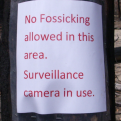


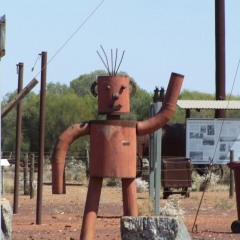
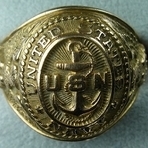
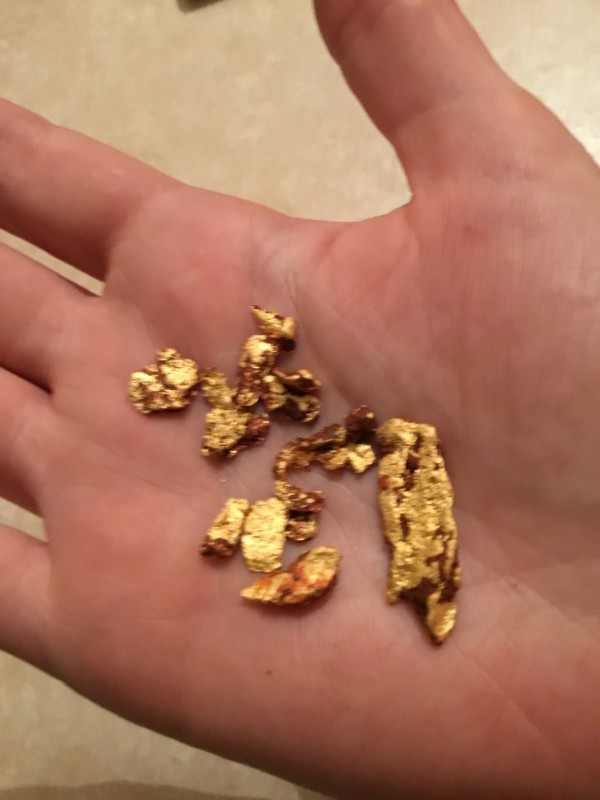
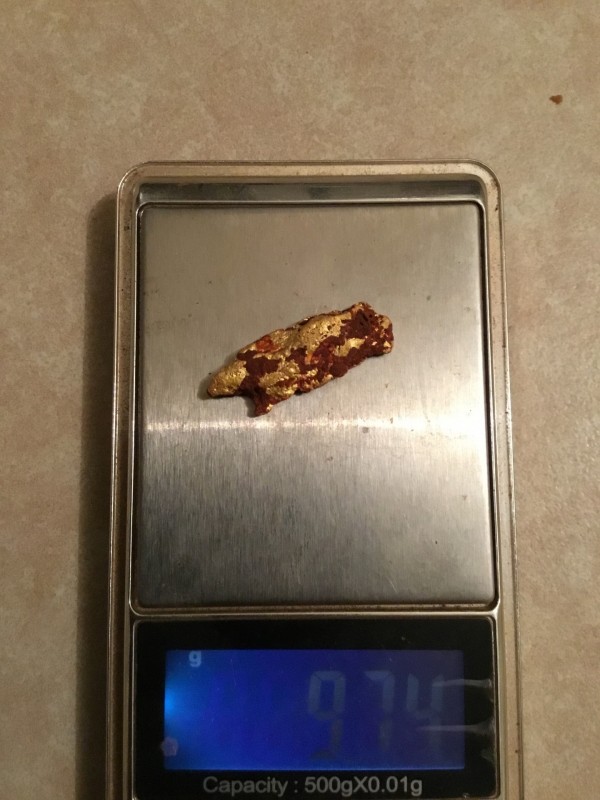


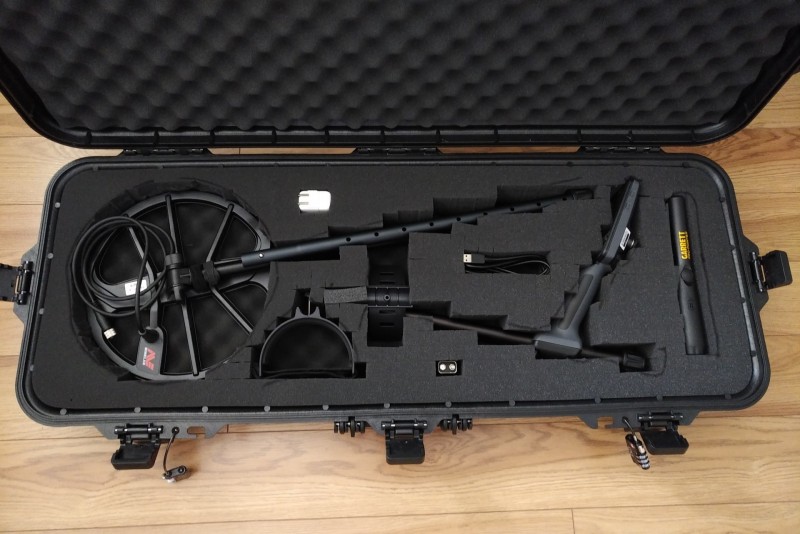
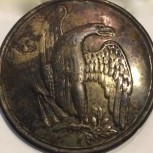
.thumb.jpg.13740cd6abe45f493193ed39c27f67fd.jpg)
.thumb.jpg.a9604472c3cce6d83a8d8fcc887e33bc.jpg)



